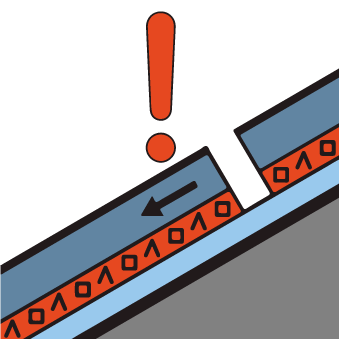
Danger level
Avalanche Problem
 | | Wind-drifted snow |
|  | |  |
 | | Persistent weak layer |
|  | |  |

As a consequence of new snow and wind there will be an increase in the danger.
The cold fresh snow and the wind slabs that are forming during the snowfall represent the main danger. Fresh and older wind slabs remain for the foreseeable future prone to triggering in all aspects above the tree line. They can be released even by a single winter sport participant. The number and size of avalanche prone locations will increase with altitude.
Additionally avalanches can also penetrate deep layers and reach large size in isolated cases, in particular at transitions from a shallow to a deep snowpack, as well as adjacent to ridgelines.
As a consequence of new snow and strong wind natural avalanches are possible by the evening.
Snowpack
dp.6: cold, loose snow and wind
In some localities up to 10 cm of snow has fallen since Monday. Along the border with Tirol 10 to 20 cm of snow, and even more in some localities, will fall from late morning. The wind will be strong. Over a wide area new snow and wind slabs are lying on soft layers.
Distinct weak layers exist in the centre of the snowpack. These can be released in some cases. Towards its base, the snowpack is largely stable. Field observations confirm the unfavourable bonding of the snowpack.
Tendency
Further increase in avalanche danger as the snowfall becomes more intense.

Danger level
Avalanche Problem
 | | Persistent weak layer |
|  | |  |
 | | Wind-drifted snow |
|  | |  |

A sometimes precarious avalanche situation will prevail. Natural avalanches are possible in isolated cases.
The fresh snow of last week and the sometimes deep wind slabs can be released easily in all aspects and generally above the tree line. Avalanches can also be released in the old snowpack and reach quite a large size. Remotely triggered avalanches are possible. The avalanche prone locations are sometimes covered with new snow and are difficult to recognise. Below the tree line the avalanche situation is more favourable. As a consequence of new snow and wind individual natural avalanches are possible, in particular in the regions exposed to heavier precipitation. This applies in particular on steep east, south and southwest facing slopes.
In the regions with a lot of snow gliding avalanches are possible, even quite large ones. This applies in particular at low and intermediate altitudes.
The conditions are precarious for snow sport activities. Caution and restraint are recommended.
Snowpack
dp.6: cold, loose snow and wind
dp.2: gliding snow
The strong wind will transport the fresh and old snow. In some places new snow and wind slabs are lying on soft layers.
In its middle, the snowpack is weak. Towards its base, the snowpack is largely stable. Whumpfing sounds and the formation of shooting cracks when stepping on the snowpack serve as an alarm indicating the danger. Released avalanches and reports filed by observers confirm the existence of a weak snowack.
Tendency
A precarious avalanche situation will persist in some cases.









